Search results for: 'mit'
-
 Ushebti für Wa-ibra-sa-Neith
Ushebti für Wa-ibra-sa-NeithGrabfigur aus Fayance, Spätzeit des Alten Ägypten, ca. 652-332 v. Chr.26. bis 30. Dynastie. Museale Erhaltung!
Price: on request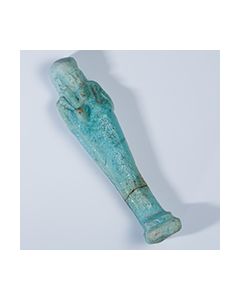 Ushebti aus der frühen Ptolomäerzeit
Ushebti aus der frühen PtolomäerzeitTürkise Fayence, sehr großes Detailreichtum. Höhe ca. 90mm, 4. Jh. v. Chr., frühe ptolomäische Periode.
Price: on request Fragment einer Konkubinen-Figur
Fragment einer Konkubinen-FigurTerracotta-Darstellung einer schönen Frau, mögl. Konkubine, Ägypten, ptolomäische Epoche.
Price: on request Scarab with cartouche of Thutmose III.
Scarab with cartouche of Thutmose III.Amulet from the New Kingdom for one of the most popular rulers in ancient Egyptian history. This scarab is described in the catalogue of Irène Gautier-Vodoz.
Price: on request Scarab with falcon headed god
Scarab with falcon headed godInteresting scarab amulet from the Second Intermediate Period. The seal shows a falcon headed creature facing an Egyptian cobra. This scarab can be found in the catalogue of Irène Gautier-Vodoz.
Price: on request Uschebti aus bemaltem Ton
Uschebti aus bemaltem TonCa. 1200 - 1070 v. Chr., Neues Reich des Alten Ägypten. Vollständig intakt, nicht restauriert. Originale Bemalung weitgehend erhalten.
Price: on request Scarab with pattern of circles
Scarab with pattern of circlesThe beetle stone bears a popular motive of the Middle Empire. A nice example of its kind. This scarab is described in the catalogue of Irène Gautier-Vodoz.
Price: on request Scarab with geometric design
Scarab with geometric designLovely scarab with traces of turquoise fayence. From the Second Intermediate Period of ancient Egypt.
Price: on request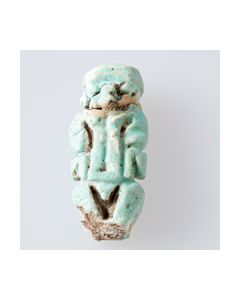 Ägyptische Patäke-Figur aus Fayence
Ägyptische Patäke-Figur aus FayenceSehr seltene Patäken-Darstellung. Ein Mensch in Zwerggestalt, der als Gott oder Gottgleicher verehrt wurde. Schutzgott. 26. bis 30. Dynastie. Spätzeit.
Price: on request Faience figurine of Isis and Horus child
Faience figurine of Isis and Horus childGoddess on a throne nursing her child Horus. Dating to the Late Period of ancient Egypt.
Price: on request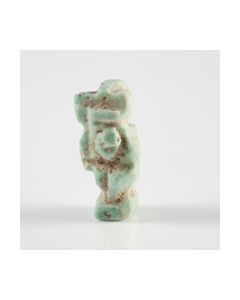 Ägyptisches Amulett der Taweret - Schutzgöttin der Schwangeren
Ägyptisches Amulett der Taweret - Schutzgöttin der SchwangerenMintgrüne Fayence. Spätzeit, Altes Ägypten, 26. bis 30. Dynastie. Hervorragender Zustand. Vollständig intakt.
Price: on request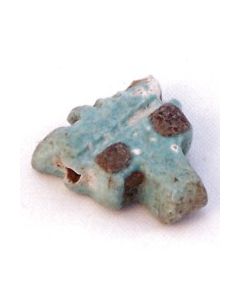 Ägyptisches Amulett aus Fayence
Ägyptisches Amulett aus FayenceAnhänger in Form der Haartracht der ägyptischen Gottheit Bes. Spätzeit des Alten Ägypten, ca. 652-332 v. Chr.26. bis 30. Dynastie. Perfekte Erhaltung. 16x14mm.
Price: on request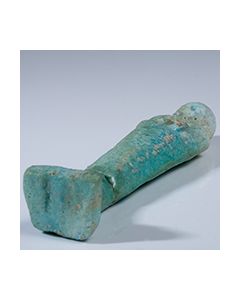 Ushebti aus der frühen Ptolomäerzeit
Ushebti aus der frühen PtolomäerzeitIntensiv-grüne Fayence, sehr großes Detailreichtum. Höhe ca. 95mm, 4. Jh. v. Chr., frühe ptolomäische Periode.
Price: on request Egyptian amulet of a hare
Egyptian amulet of a hareThis type of amulet was popular in the Late Dynastic Period of Ancient Egypt. It should endow its wearer with fertility and rapidity of movement. The piece was exhibited in an early 20th century private museum.
Price: on request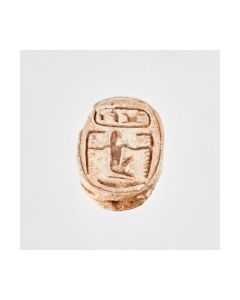 Scarab with god Heh and cartouche
Scarab with god Heh and cartoucheInteresting motive showing the kneeling god of endlessness with palm stem in both hands. Above him the cartouche of pharao Mencheperre. Around the 18th dynasty of ancient Egypt.
Price: on request Scarab with twisted cord
Scarab with twisted cordScarab amulet with a twisted cord motive. Beautiful and well preserved piece from the Second Intermediate Period.
Price: on request Ägyptischer Spielwürfel aus Bein
Ägyptischer Spielwürfel aus BeinAlter Fund aus Abydos des Egyptian Exploration Funds (heute EES).
Price: on request Scarab with sphinx
Scarab with sphinxThe stamp depicts a human headed sphinx walking towards the Ankh symbol of life. The amulet should exert a protective function on the one carrying or owning it.
Price: on request Egyptian ushabti for Ra-mes
Egyptian ushabti for Ra-mesThe mummiform funerary figurine dates to the Late Period of ancient Egypt, 26th to 31st dynasty. It is remarkable that it probably originates from the burial of two brothers, Ra-mes and Somtus-tefnacht.
Price: on request Ushabti for Ra-mes
Ushabti for Ra-mesThe mummiform funerary figurine dates to the Late Period of ancient Egypt, 26th to 31st dynasty. It is remarkable that it probably originates from the burial of two brothers, Ra-mes and Somtus-tefnacht.
Price: on request Egyptian ushabti for Somtus-tefnacht
Egyptian ushabti for Somtus-tefnachtThe mummiform funerary figurine dates to the Late Period of ancient Egypt, 26th to 31st dynasty. It is remarkable that it probably originates from the burial of two brothers, Somtus-tefnacht and Somtus-tefnacht.
Price: on request Egyptian ushabti for Somtus-tefnacht
Egyptian ushabti for Somtus-tefnachtThe mummiform funerary figurine dates to the Late Period of ancient Egypt, 26th to 31st dynasty. It is remarkable that it probably originates from the burial of two brothers, Somtus-tefnacht and Somtus-tefnacht.
Price: on request Egyptian ushabti for Somtus-tefnacht
Egyptian ushabti for Somtus-tefnachtThe mummiform funerary figurine dates to the Late Period of ancient Egypt, 26th to 31st dynasty. It is remarkable that it probably originates from the burial of two brothers, Somtus-tefnacht and Somtus-tefnacht.
Price: on request Ushabti for Somtus-tefnacht
Ushabti for Somtus-tefnachtThe mummiform funerary figurine dates to the Late Period of ancient Egypt, 26th to 31st dynasty. It is remarkable that it probably originates from the burial of two brothers, Somtus-tefnacht and Somtus-tefnacht.
Price: on request Egyptian ushabti for Somtus-tefnacht
Egyptian ushabti for Somtus-tefnachtThe mummiform funerary figurine dates to the Late Period of ancient Egypt, 26th to 31st dynasty. It is remarkable that it probably originates from the burial of two brothers, Somtus-tefnacht and Somtus-tefnacht.
Price: on request Egyptian ushabti for Somtus-tefnacht
Egyptian ushabti for Somtus-tefnachtThe mummiform funerary figurine dates to the Late Period of ancient Egypt, 26th to 31st dynasty. It is remarkable that it probably originates from the burial of two brothers, Somtus-tefnacht and Somtus-tefnacht.
Price: on request Egyptian ushabti for Somtus-tefnacht
Egyptian ushabti for Somtus-tefnachtThe mummiform funerary figurine dates to the Late Period of ancient Egypt, 26th to 31st dynasty. It is remarkable that it probably originates from the burial of two brothers, Somtus-tefnacht and Somtus-tefnacht.
Price: on request Egyptian scarab with papyrus plants
Egyptian scarab with papyrus plantsScarab amulet made of bright, almost white steatite. 13th to 15th dynasty. This scarab is described in the catalogue of Irène Gautier-Vodoz.
Price: on request Scarab with scarab motive
Scarab with scarab motiveThe stamp side shows a scarab with two uraeus snakes. This scarab is described in the catalogue of Irène Gautier-Vodoz.
Price: on request Scaraboid with twisted cord
Scaraboid with twisted cordScaraboid seal amulet with a twisted cord motive. This scarab is described in the catalogue of Irène Gautier-Vodoz.
Price: on request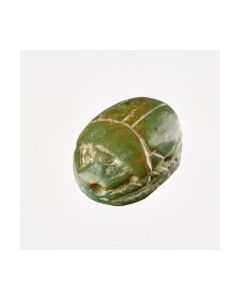 Scarab with Amun inscription
Scarab with Amun inscriptionBearing the hieroglyphs "the god Amun of Theben is lord". From the Late Period of ancient Egypt. Beautiful green stone.
Price: on request Scarab with geometric motive
Scarab with geometric motiveThe lower side exhibits a symmetrical arrangements of cords, two of which are wrapped around each other. This scarab is described in the catalogue of Irène Gautier-Vodoz.
Price: on request Egyptian ushabti for Ra-mes
Egyptian ushabti for Ra-mesThe mummiform funerary figurine dates to the Late Period of ancient Egypt, 26th to 31st dynasty. It is remarkable that it probably originates from the burial of two brothers, Ra-mes and Somtus-tefnacht.
Price: on request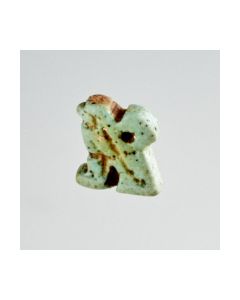 Egyptian amulet of a falcon
Egyptian amulet of a falconThe falcon in Egyptian art can be a depiction of the god Horus or symbolize the soul of the pharao. Falcon amulets are known from the earliest times in Egyptian history. However this speicmen dates to the Late Dynastic Period of Ancient Egypt.
Price: on request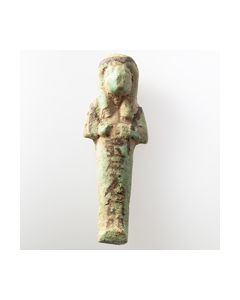 Ushabti des Nes-ta-hi
Ushabti des Nes-ta-hiÄgyptische Statuette, rund 80mm hoch, 22. Dynastie. Ausgeprägte Gesichtszüge, schöne blau-grüne Fayence. Hieroglyphen in etwa Osiris, Nes-ta-hi, maa-kheru.
Price: on request Ushabti des Nes-ta-hi
Ushabti des Nes-ta-hiÄgyptische Statuette, rund 80mm hoch, 22. Dynastie. Ausgeprägte Gesichtszüge, schöne blau-grüne Fayence. Hieroglyphen in etwa Osiris, Nes-ta-hi, maa-kheru.
Price: on request

